
Line 1, shortened to L1, coloured red and often simply called Línia vermella, is the second oldest Barcelona Metro line, after line L3. It is the longest line of the Barcelona Metro, and links L'Hospitalet de Llobregat and Santa Coloma de Gramenet. Originally operated by the independent Ferrocarril Metropolitano Transversal de Barcelona, it is today operated by Transports Metropolitans de Barcelona (TMB) and is part of the ATM fare-integrated main transport system. L1 is the only metro line in Spain to use Iberian gauge tracks, as used by most Spanish main line railways.
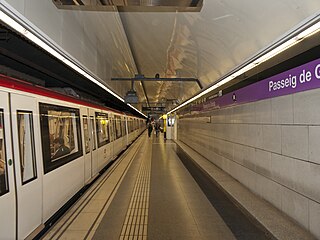
Line 2 is a metro line in Barcelona operated by TMB, coloured purple and sometimes called línia lila. It is part of the city's ATM fare-integrated transport network.

Line 4, also known as Trinitat Nova – La Pau, usually called "línia groga", is a line in the Barcelona Metro network operated by TMB, and part of the ATM fare-integrated transport network. It serves the northern districts of the city, and it is being extended to the new major metro and rail stations Estació de la Sagrera and Sagrera-Meridiana.

Line 9 is a completely automated line of the Barcelona Metro network that is currently under construction, with 24 stations open in Barcelona and El Prat de Llobregat, L'Hospitalet de Llobregat, Badalona and Santa Coloma de Gramenet suburbs, since December 2009. The line is currently disconnected in two branches, with a connecting part between the two yet to be built. The Aeroport T1 – Zona Universitària section is called L9 South, and the La Sagrera – Can Zam portion L9 North. Upon completion, it will be the longest underground metro line in Europe.

Fondo is a Barcelona Metro station in the municipality of Santa Coloma de Gramenet, in the northern part of the metropolitan area of Barcelona. It is served by two metro lines, L1, of which it is the northern terminus, and L9. It was built in 1992 under Camí Fondo de Badalona, in the neighbourhood of Fondo, between Carrer Dalmau and Carrer Verdi.
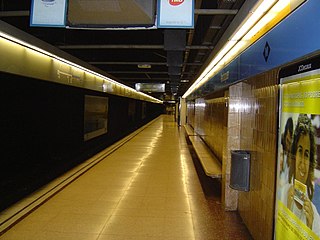
Verdaguer is a station in the Barcelona metro network, located under Plaça de Mossèn Jacint Verdaguer, in Eixample, named after the Catalan poet Jacint Verdaguer. It's served by L4 and L5.
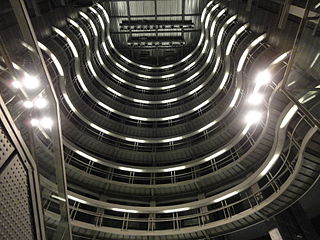
Line 10 is the name of one of the two branches of the Barcelona metro line 9, currently (2020) under construction and to be operated by TMB. Like Line 9 and Line 11, it will be an automatic train operation metro line.
Line 13 is the name of a proposed service in the Barcelona Metro network which would join La Morera (neighborhood) in Badalona, a municipality of Barcelonès to the north of Barcelona, with the hilly area around Can Ruti Hospital. The line, which will be a short hybrid light rail-metro addition to the main subway lines which will cover a poorly communicated area, similar to L11, was announced in 2002 by Generalitat de Catalunya. It was also made public the line will be displayed in maps using a shade of pink.

Gorg is a Barcelona Metro and Trambesòs complex named after the neighbourhood of the same name where the station is situated, in Badalona municipality. It is located on Avinguda del Marquès de Mont-Roig and very close to Palau Municipal d'Esports de Badalona, the home arena of the professional basketball club Joventut de Badalona. It is served by TMB-operated Barcelona Metro lines L2 and L10, and Trambesòs route T5.

Badalona Pompeu Fabra is the name of a Barcelona Metro station in downtown Badalona, a municipality in the metropolitan area of Barcelona, served by metro line L2, and its northern terminus. Saveguarded plans for the extension of L1 also include this station. It's named after Pompeu Fabra, grammarian and political figure.
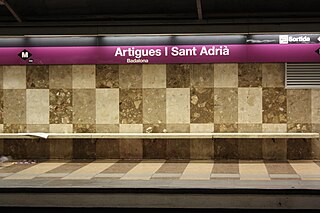
Artigues | Sant Adrià is a Barcelona Metro station in Badalona, named after the neighbourhood of the same name. Despite the latter part of the name, it is not in Sant Adrià del Besòs, and the tag Badalona was added to all signage in the station to avoid confusion. It is served by L2. It opened in 1985 with the name Joan XXIII as part of L4 and became a L2 station in 2002. It can be accessed from Carretera de Santa Coloma and from Avinguda de Joan XXIII.

Sant Roc is a Barcelona Metro station in Sant Roc, a neighbourhood of the municipality of Badalona, in the metropolitan area of Barcelona. It's served by L2 and since 2007, by Trambesòs route T5. It was opened in 1985 as part of L4 and moved to L2 in 2002. It can be accessed from Plaça President Tarradellas and from Carrer Alfons XII.
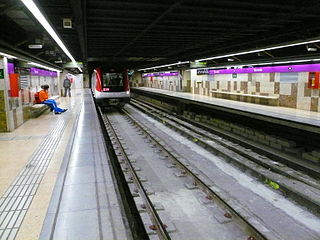
Verneda is a Barcelona Metro station in the Verneda neighbourhood of Sant Adrià de Besòs, a suburb of Barcelona. It's served by L2. It was opened in 1985, although it was part of L4 back then, until a major change in both lines took place in 2002 to ease transportation from Badalona to Barcelona. The platforms are 93 m. long.
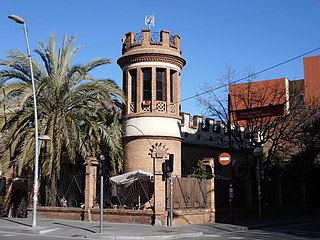
Casa Agustí is a modernista building in the Progrés quarter of Badalona built in 1893. It was designed by the renowned architect Lluís Domènech i Montaner as the residence of the engineer Eduard Agustí Saladrigas. The building became a restaurant in 1936 and currently serves food and refreshments. Among its remarkable features are the round red brick tower and the surrounding gardens. The nearest existing Barcelona Metro station is Pep Ventura, and notoriously the undergoing extension of the metro network has allegedly damaged its façade.

La Verneda i la Pau is the northernmost neighborhood of the Sant Martí district of Barcelona, Catalonia (Spain). It borders the neighboring municipality of Sant Adrià de Besòs.
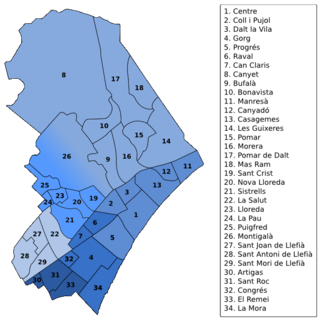
Centre is the usual name for the central area of Badalona, a locality in the metropolitan area of Barcelona. It's located in the District 1 by the Mediterranean Sea, and is a commercial and residential area with good transportation connections. It had 1344 inhabitants in the 2010 census.

Sant Roc is a neighbourhood of Badalona, in the metropolitan area of Barcelona. In 1958 the Badalona city council planned construction on the site, under the name of Barrio del Regadío. It was urbanised beginning in December 1962 and originally inhabited by people resettled from slums in the Barcelona area, after damages caused by major floods. Still nowadays it has an important Roma presence. The Francoist housing organisation Obra Sindical del Hogar y Arquitectura was responsible for most of the construction in Sant Roc, mostly made up of tower blocks.

Gorg is a neighborhood of Badalona which belongs to the town's District 5 and consequently part of the metropolitan area of Barcelona. Gorg owes its origins to the Industrial Revolution and the substantial growth of the Barcelona area. It still contains a great number of factories, but the area has been recently subject to profound changes. Developers related to Marina Badalona have been involved with the ongoing transformation of the area. The area is home to the 1992 Summer Olympics venue Palau Municipal d'Esports de Badalona. Construction of an urban canal connecting the marina with the sports arena through Gorg has long been put on hold until now that many real state agencies are detecting the raise of a new and modern neighborhood and the canal is already constructed.

El Progrés is a coastal area of Badalona in the town's District 1, and as such, part of the metropolitan area of Barcelona. It is bordered by Gorg, La Mora, Raval, Can Claris, Centre and the Mediterranean Sea. As of the 2012 census El Progrés had 11,059 inhabitants, or 5% of Badalona's population. Like many toponyms in the town the name of this neighbourhood —which is Catalan for "The Progress"— evokes the industrial age which was the time of its inception.

















